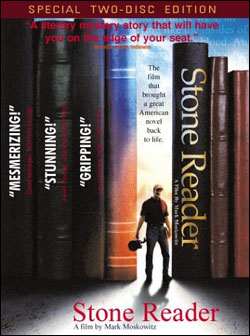|
Reviews of Recent Independent, Foreign, & Documentary Films in Theaters and DVD/Home Video
STONE READER
DVD Special Features
Stone Reader is a rather subjective and extremely personal depiction of the search for
how and why reading holds such great significance for, and influence on, so many people. Mark
Moskowitz, having been convinced as a college student in 1972 by a rave New York
Times book review to read Dow Mossman’s novel, The Stones of Summer, was not able to
get through it then. He did not get back to it again until 25 years later, at which time he thought
it was a phenomenal work. Looking for other books by Mossman, Moskowitz was mystified to
discover that the author never had anything published again, and had virtually disappeared off the
face of the earth. The film goes on to document Moskowitz’s adventures as he attempts to solve
the mystery of Mossman’s fate, and to ultimately track him down. Moskowitz finds himself in
discussions with such literary giants as critic Leslie Fiedler and Catch-22 editor Robert
Gottlieb. Fiedler suggests that
authors have to fall in love with writing, and with discovering themselves, in order to do what
they do – to which one could add that some part of the reader must do so as well. Perhaps,
though, author Frank Conroy sums it up best when he intones, regarding reading: “You feel the
pressure of another human soul on the other side of the book. And that makes you feel less alone,
and less trapped in your body. And less isolated…It’s almost spiritual.” Indeed it is. And as the
camera pans across shelves of books, viewers might start looking out for their favorites, such as a
stray Aldous Huxley or Kurt Vonnegut, and in this way feel that the film has captured readers’
ability to recognize some of themselves in another person who has read the same books.
Fittingly, that is the film’s most salient trait: the manner in which it communicates the
near-communal quality of reading, with storytelling emerging - since the age of hieroglyphics, as
its title also alludes to - as one of the most resonant human needs. Through it all, Moskowitz’s
sly sense of humor comes through. The film’s vistas of the Maine and Iowa landscapes stand out,
along with the evocative music. However, one feels the movie’s structure is flawed: at one point,
it becomes clear that Moskowitz is postponing a crucial development for maximum suspenseful
impact, a move that is too obviously contrived. Some scenes featuring Moskowitz’s children try
too hard to make the connection between books and their effects during childhood more explicit
– a link that has by then been established. Finally, the viewer might feel as if there should
be more about the novel itself - a Midwestern coming-of-age epic - since the movie ends up
being more about Moskowitz than Mossman or his book. Regardless, what happened to Mossman is a riveting story in itself.
DVD Extras: Most interesting for literary aficionados is a 1974 episode of Firing
Line in which William F. Buckley and interviewee Fiedler seem to be attempting to
outdo each other’s pretentiousness, with Fiedler hilariously making hand gestures that at one
point result in a seemingly oblivious giving of the finger to one of his questioners. Book fans will
also enjoy the Henry Roth segment, which compares the experiences of the similarly forgotten
author of Call It Sleep with Mossman’s. The interview with Betty Kelly, one of the
original editors of Mossman’s novel, emphasizes how much people were rooting for him to write
another book. A funny anecdote is found on the “What Happened Next” featurette in which
another fan of the book relates his frantic mission to bid for it online. The list of book
recommendations and the literary web resources will also be appreciated by the book
connoisseur. The piece de resistance, however, is an Easter egg found among the extras, a
short skit in which William Faulkner is asked permission by (what appears to be) a bad actor playing a
reporter to write a story on Faulkner’s everyday life. One minor gripe: the
segment in which Moskowitz talks to Janet Maslin, claiming that everything in the film occurred
as it happened, does not ring true, given the way the movie plays out and some obvious facts to
the contrary that Moskowitz states right after his initial proclamation, something which Maslin
lets him get away with too easily. A short film, “First Story,” directed by Cindy Stillwell, is
puzzling, since it consists entirely of footage of rodeos and trains, and is shown without any
explanation. As for the audio commentary, it is a treat to hear Mossman and Moskowitz get
along so well. One gets the feeling that Mossman is as genuinely grateful as he says he is, and it
is, admittedly, a kick to hear a writer appreciate other writers so blatantly. Furthermore, it is fun
to hear Mossman, in his folksy way, marvel at why paperback bindings are so easily broken in
the industrial power that is the United States, as well as slightly criticize Moskowitz’s film, at
one point calling his technique “schizoid.” Reymond Levy
|
